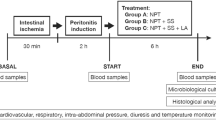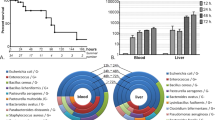Abstract
Background: Laparoscopic surgery is being used now for increasingly diverse clinical applications, including diagnosis and treatment of appendicitis and bacterial peritonitis. However, some concerns and controversies exist regarding the effectiveness of laparoscopic irrigation of the abdominal cavity compared with that achieved during laparotomy. Of no less importance is concern that establishing a CO2 pneumoperitoneum in patients with cardiopulmonary insufficiency or endotoxemic shock may compromise hemodynamic function. The objective of this randomized, controlled study was to determine the effects of laparoscopic versus laparotomy intervention on hemodynamic and outcome measurements using a porcine model of Escherichia coli peritonitis.
Methods: For this study, 24 specific pathogen-free Hanford pigs underwent surgical placement of carotid, Swan-Ganz, and peritoneal catheters. After a 24-h recovery period, one subset of pigs (n= 12) received a bolus infusion of 9 × 108 CFU/kg E. coli intraperitoneally (septic) and intravenous fluid resuscitation. The remaining 12 pigs were not challenged with E. coli (control). Twenty-four hours later, all 24 pigs underwent either laparoscopic or open peritoneal irrigation with saline, then were reevaluated 48 h after surgical intervention. Standard cardiopulmonary, hematologic, and bacteriologic assessments were obtained both perioperatively and 48 h after surgical intervention.
Results: Pigs given E. coli exhibited significantly elevated heart rates and core temperatures and decreased O2 saturation during the initial 6 h. Within 24 h, these pigs exhibited respiratory alkalosis, altered blood leukocyte profiles, and E. coli–infected peritoneal fluid. Random blood samples from the septic pigs tested negative for E. coli. Mean pulmonary artery and capillary wedge pressures were lower (p < 0.05) in septic than in control pigs before and after surgical intervention. Septic pigs that underwent laparoscopy had significantly lower (p < 0.05) arterial pH and higher arterial pCO2 levels than septic pigs after laparotomy. Other cardiopulmonary responses were similar irrespective of the surgical modality used. One of six septic pigs from each surgical group still had E. coli growth in its peritoneal fluid 48 h after surgical intervention.
Conclusion: Laparoscopic intervention demonstrated effectiveness equal to that of laparotomy for treating acute E. coli peritonitis in pigs without septic shock.
Similar content being viewed by others
Author information
Authors and Affiliations
Additional information
Received: 26 June 1998/Accepted: 12 January 1999
Rights and permissions
About this article
Cite this article
Palombo, J., Liu, K., Greif, W. et al. Effects of laparoscopic vs laparotomy treatment of E. coli peritonitis on hemodynamic responses in a porcine model. Surg Endosc 13, 1001–1006 (1999). https://doi.org/10.1007/s004649901156
Published:
Issue Date:
DOI: https://doi.org/10.1007/s004649901156




